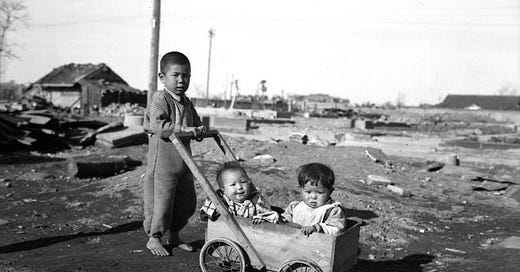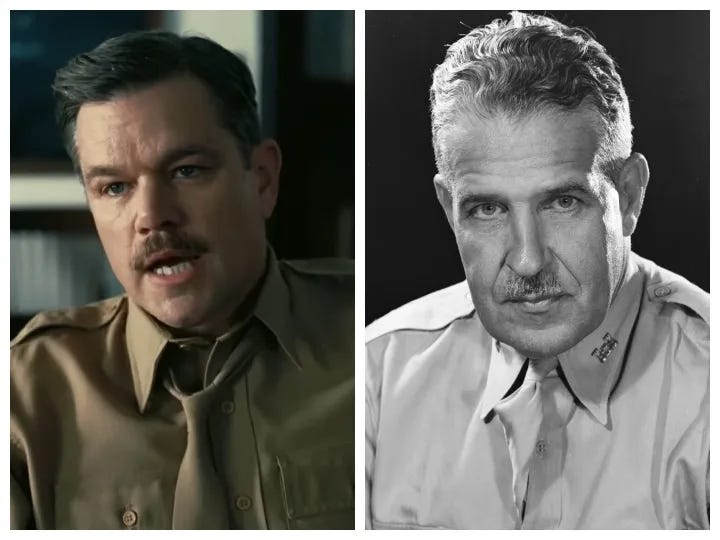Nagasaki: The Forgotten Bomb
Always "the Second City," but many consider the attack a "war crime." The Nolan movie did not help matters at all.
It’s in vain to recall the past, unless it works some influence upon the present.— Charles Dickens
Greg Mitchell is the author of a dozen books, including “Hiroshima in America,” “Atomic Cover-up,” and the recent award-winning “The Beginning or the End: How Hollywood—and America—Learned to Stop Worrying and Love the Bomb.” He has directed three documentary films since 2021, which have all aired over PBS (you can still watch “Atomic Cover-up”).
Nagasaki Day arrives again on Friday. Naturally I wrote a major piece about this atrocity —and Oppenheimer barely mentioning it—last year at Mother Jones, my third piece for them last summer in response to the Nolan movie (see here and here). Go over there and read the entire story but I’ll excerpt a bit from it below on the man who took charge of that tragedy, Gen. Leslie Groves.
Reminder: Groves preferred to be called “Dick.”
In truth, the man behind the Nagasaki bomb was not Truman, but Gen. Leslie R. Groves, director of the Manhattan Project. Earlier he had fiercely promoted using the first bomb and stifled attempts by scientists (not including Oppenheimer) to convince Truman otherwise. Truman had never explicitly endorsed the notion of a necessary “one-two punch.” It was Groves who was the true believer and catalyst. As soon as Hiroshima was bombed he pushed for the second mission as soon as possible, just as authority for the next attack had devolved to him from Truman (who was on a ship in the Atlantic returning from Potsdam). Groves himself would later boast, “I didn’t have to have the president press the button on this affair.”
The second bomb run was originally set for around August 11 and, if adhered to, this would have come a full day after Japan’s initial surrender offer. But bad weather was forecast, so Groves pushed the mission up two days, even knowing the conditions might not be any better and that he would have to rush preparations on the island of Tinian in the Pacific. Another problem: pilots had been ordered to only release the weapon when the target was found visually—not just by radar.
As it turned out, stormy conditions remained in the forecast for August 9. The lead plane, piloted by Charles Sweeney, took off anyway and despite a faulty fuel pump. Then he found the primary target, Kokura, covered by clouds. He pushed on to Nagasaki despite dwindling fuel. Then the crew found that city shrouded. When a small gap in the overcast was spotted—or so was the bombardier’s claim--the payload was released, off target but still lethal.
All of this was set up by Groves’ determination for what he called a “knockout blow,” which he had signaled down the line to subordinates and to pilot Sweeney (even though Japanese leaders barely had time to absorb the shock and devastation from bomb number one). The means to an end had become an end in itself. Groves would explain “once you get your opponent reeling, you keep him reeling and never let him recover.” Groves, as war scholar Ian Clark observed, “was prepared to sacrifice all of the previously elaborated guidelines in order to implement his own strategy.”
Then Groves had the nerve to claim, in his memoir, Now It Can Be Told, that he was actually “considerably relieved” to learn the Nagasaki bomb had landed off target, meaning “a smaller number of casualties than we had expected.” But when reports of deaths from radiation disease in Japan emerged in the weeks after the bombings, he called this “a hoax or propaganda,” wondered if there was “any difference between Japanese blood and others,” and claimed that he had been told by doctors that radiation sickness “is a very pleasant way to die.”
Matt Damon, who portrayed Groves with much sympathy in Oppenheimer, should thank his lucky stars (and Christopher Nolan) for sparing him the task of delivering those lines in the movie.
When I spent a week in Nagasaki in 1984 on a journalism grant—a length of time extremely unusual for Americans—it proved even more haunting than Hiroshima, where I stayed for over two weeks on the same trip. You’ll get some of the reason in that Mother Jones piece but maybe it was also because of its semi-tropical beauty and its long history, its unusually stoic survivors, and the fact that the bombing should not have happened, by any measure.
And the plutonium bomb was nearly twice as powerful as the uranium “gadget” used over Hiroshima. If it had not exploded off-target, the death toll and survivor agony would have likely exceeded Hiroshima’s.
Then there was this, captured in this excerpt from my Atomic Cover-up book. I would guess this ceremony is still held on this date:
Every year at nine a.m. on August 9 in Nagasaki, students gather at the three-story Yamazato Elementary School (which was founded about 1870), half a mile from ground zero. We found them assembled in the schoolyard, neatly dressed in white shirts or blouses and black shorts, the girls in bright yellow sun hats. They sat on folding chairs, the kids in the first few rows cradling paper cranes on their laps. This school, which was badly damaged by the bomb, became famous as an impromptu medical station for the injured. It was still being used for that purpose months later when the elite U.S. Army film team shot (the later suppressed) footage there.
As we watched from the playground, amid the monkey bars, the school principal told the young crowd, “No students were here on that day, we were not in session, but this did not save them. Over 1300 of your former classmates died that day. Now you are 780 in number. Look around you and imagine all of you plus 500 of your brothers and sisters perishing.”
My own daughter was barely out of elementary school so tears filled my eyes. Indeed, the death toll of children from this one school eclipsed by more than a thousand the total number of Japanese military personnel killed in Nagasaki that day. The school also lost twenty-eight of its forty-two teachers.
The principal told the students that while it seemed to be peaceful today, there now exist in the world thousands of nuclear weapons each many times more powerful than the bomb that killed these children and parents. “This is the one school in the entire world most touched by the atomic bomb," he pointed out, "so you must say, no more nuclear weapons.”
Then, in the sweltering heat, the students poured cups of cold water on a stone memorial to the victims, to console them.






Wouldn't a "reason" for Nagasaki be that they wanted to try out the plutonium bomb? See how much more destructive it might be than the uranium one?
thank you for your continuous reminders of the two greatest atrocities man has perpetrated against man , it has been a gradual descent toward hell ever since